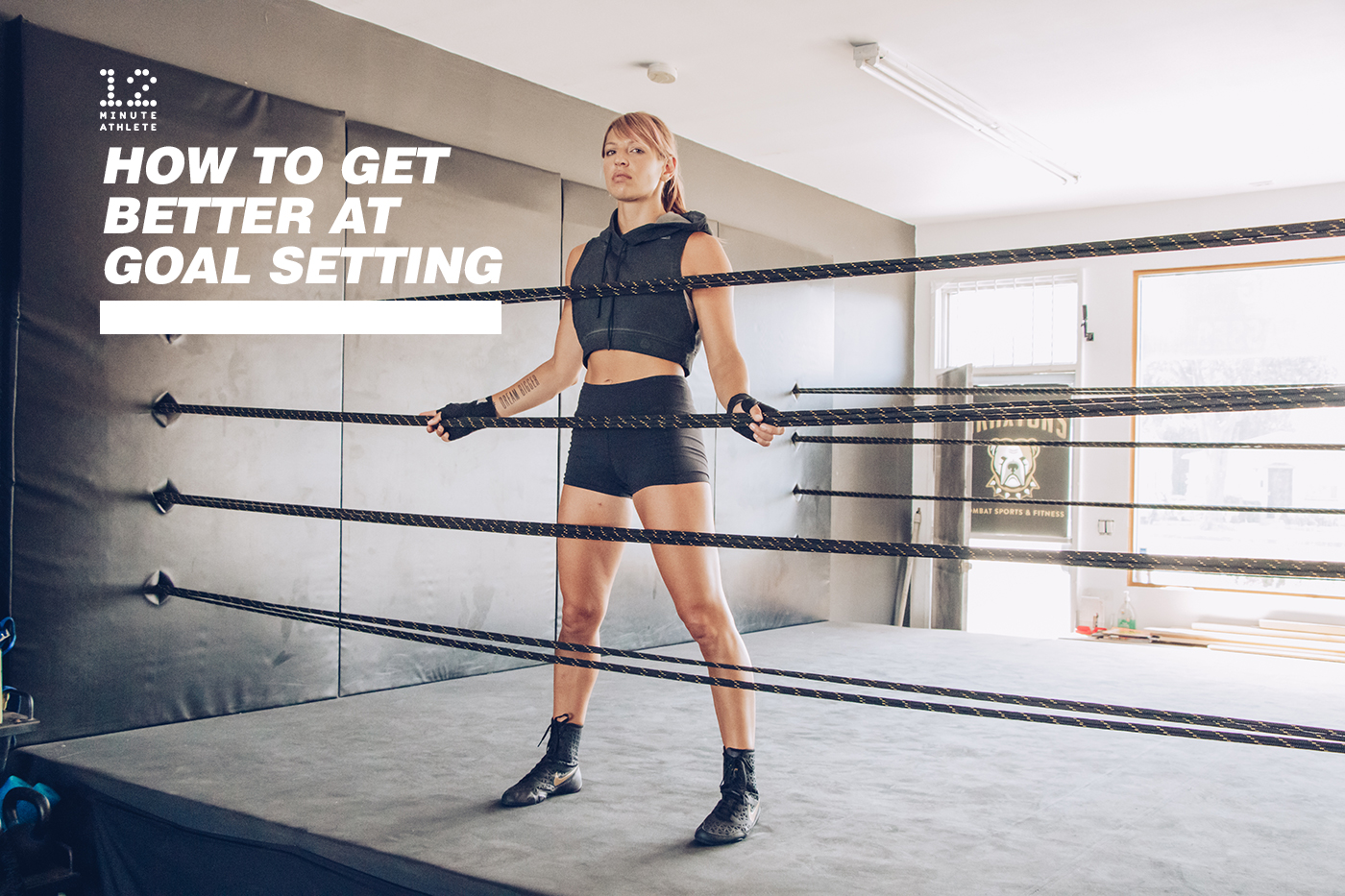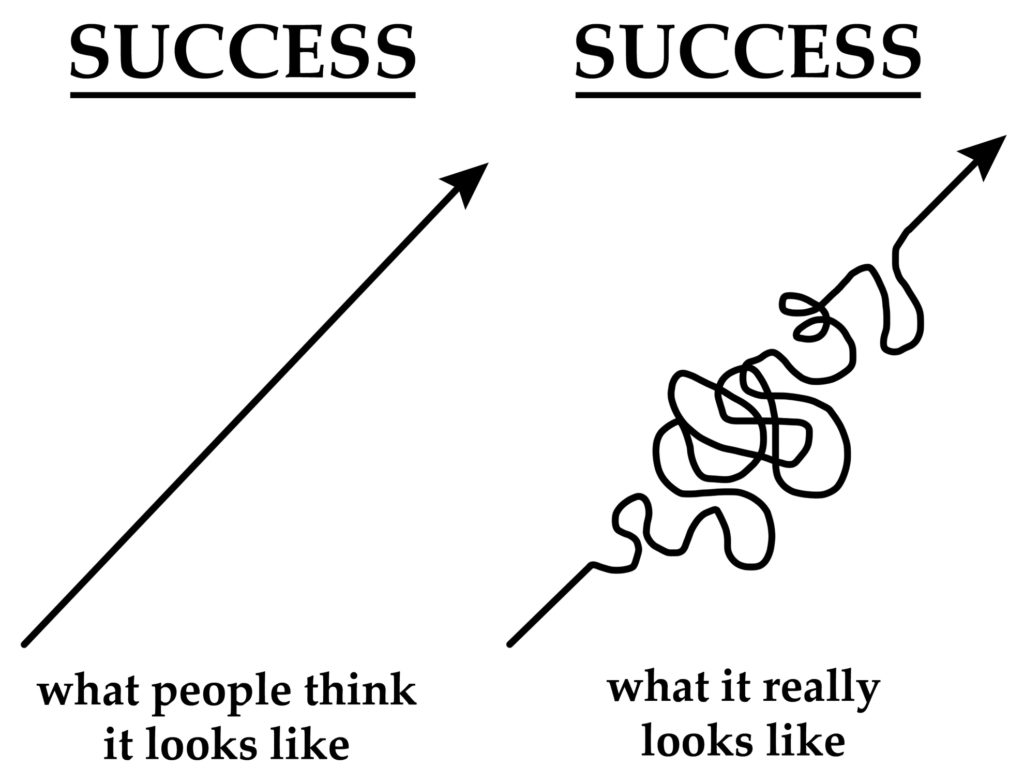The health and fitness community loves to talk about setting goals—especially around New Year’s, when so many people make goals for the rest of the year.
But the percentage of people who set goals January 1st then actually go on to achieve those goals is minuscule.
In fact, while the average person sets a number of New Year’s resolutions at the beginning of the year, nearly 80% of people have given up by the end of a 30-day period. And only 8% of people actually follow through on their resolutions and end up achieving their goals.
So what’s going on here? Why can’t people stick to their goals?
It’s not because everyone who sets New Year’s resolutions is automatically unmotivated and not driven to succeed.
It’s because most people don’t actually know how to set goals that stick.
Goal setting is an incredibly powerful way to boost productivity and performance, which is why we talk about it so much here at 12 Minute Athlete. Thankfully, even if goal setting isn’t something you currently consider yourself to be very good at, you can get better at it.
First, you’ll need to understand how to set better goals. From there, you can learn the simple tricks that will help you to stick with them over time, even when it gets tough.
Better goal setting means more goals achieved, period.
Let’s look at how to start improving at goal setting so that you can crush your goals all year round.
Set High, Hard Goals
It seems logical that if you set goals that are just slightly out of your comfort zone, you’d be more likely to achieve them (versus setting goals far outside of your wheelhouse).
But the research on goal setting actually shows the exact opposite. Gary Latham, a psychologist who has spent decades researching goal setting, says that if you want the biggest increase in motivation and productivity, set your goals high.
“Big goals lead to the best outcomes,” says Latham. “Big goals significantly outperform small goals, medium-sized goals, and vague goals.”
Examples of high, hard fitness-related goals could be to train for and compete in your first boxing or martial arts competition, to climb Mt. Everest, or to be able to do 10 pull ups in a row when you currently can’t do a single one.
The reason you’re more likely to achieve harder goals versus smaller ones is that having a big challenge forces you to focus on your goal. Not only that, but it forces you to be more consistent.
You can’t try to squeeze all the work in right before the deadline—you have to work on it consistently over time. And that’s the key to making long-term progress.
Think about it: if you just made a goal to climb Mt. Everest, you know right away that you’ll need to devote a good part of your daily life to training toward that goal. You’ll need to do the strenuous physical training which will take up a lot of your time, as well as find a team, get and prep all the right gear, and do all the other things you need to prepare for such a huge endeavor.
Because you don’t want to go into such a big goal unprepared, you’ll plan from the get-go to structure your life around that goal, and you’ll also do your absolute best to maintain a consistent schedule so that you don’t fall behind in your training.
Ultimately, setting high, hard goals helps you stay more focused and consistent working toward your goal.
Make Sure Your Goals are Clear
One of the main reasons most people fail at reaching their New Year’s resolutions or other goals is that they start out with too general of a goal.
Year after year, one of the most common New Year’s resolutions people set is “to lose weight.”
It’s also the one that most people fail at the most.
So why don’t general goals like “I want to lose weight” work? For many reasons:
- General goals don’t set you up for clear ways to track your progress. A crucial piece of successful goal setting is knowing when you’re making progress toward your goal and actually keeping track of it. That way you can know right away if your progress starts to slow down and work extra hard to get back on track.
- Without specific markers along the way, you’re unlikely to feel like you’re making progress, even when you are—meaning you’re more likely to quit sooner.
- Without a clear vision of your goal, it’s easy to feel overwhelmed or discouraged before you even start.
To avoid this, make sure your goals are both clear and measurable. For example, rather than just making a goal to lose weight, instead make a goal to reduce your current body fat percentage by 10% and be able to confidently wear a specific pair of jeans.
Better yet, make your goals non-appearance related for even greater sticking power and lasting motivation. Goals such as being able to hold a five-second freestanding handstand (more on my own handstand journey below), to compete in your first obstacle race, or to be able to confidently climb a challenging rock climbing route are all non-appearance related goals that in my experience, lead to a lifelong consistent fitness habit.
Break Down Your Goals into Chunks
“Never stop dreaming, just don’t let it replace the doing.” – Chase Jarvis
So how do you actually go about working toward your high, hard goals without getting so overwhelmed you never actually start?
As you might have personally experienced in past goal setting attempts, it simply doesn’t work to just set that big, far-reaching goal and try to achieve the whole thing right away. High, hard goals require time to pursue, and if you’re always just thinking of that one big goal, you’re probably going to get discouraged and maybe even quit before you really get started.
I see a lot of people get stuck in this stage of goal setting, which can basically just be thought of as the dreaming stage.
There’s no question that dreaming of your big goals can be a lot of fun. Personally, dreaming about all the things I want to accomplish one day is one of my favorite things to do when I’m feeling inspired.
The truth is that it’s easy to dream and to come up with big dreams you’d love to accomplish one day—but actually putting in the work and taking concrete action steps toward your goals is a whole different animal.
So how do you make a high, hard goal accessible so that you can start chipping away at it?
Simple: you break it down into chunks.
Ideally, these chunks include:
- Small, action steps you can take on a daily basis
- Short-term goals you can work toward on a weekly and/or monthly basis
- Mid-range goals you can aim for on a half-yearly and yearly basis
And so on. The bigger your goal, the longer you’ll need to plan for, and the more you’ll need to break your larger goal down into smaller action steps you can follow now and in the near future.
This chunking does a few important things: first and foremost, it gives you a way to actually track your progress by giving you objective metrics you can check off along the way. It also helps you avoid being too overwhelmed by the immensity of your end goal, making it less likely you’ll get discouraged and quit.
Chunking goals is how all elite performers (whether in athletics or other fields) are able to eventually reach mastery and accomplish really amazing things. It’s such an important strategy for long-term goal setting, yet it my experience it’s not one that we’re really taught how to do in our traditional education systems.
Attach Your Goals to a Timeline
Think about any high performers you know, whether they’re athletes, founders of successful companies, authors, artists, etc. When they set their high, hard goals, do you think they leave the timing open-ended and just plan to get to them whenever they feel like it?
Of course not.
High performers in any field are able to accomplish so much not only because they’re able to break their goals down into small, manageable steps, but also because they attach their goals to a timeline.
Whether it’s to train for a competition, get their startup ready for the next round of funding, or to get that first draft of their new book to their publishers, people who consistently crush their short and long-term goals live by deadlines, whether they’re external or self-imposed.
And this is where I see many people go wrong when setting their goals to begin with: they set a goal without attaching it to any sort of timeline. Either that or they attach it to an arbitrary (and often unrealistic) timeline without really understanding the steps or the work it will take to achieve it.
“I want to lose ten pounds,” “I want to be able to do a pull up,” and “I want to be able to ski that black diamond run with confidence” are all common, clear goals people might set with the best of intentions to follow through on them. But without an actual deadline, they’re unlikely to actually make any significant progress toward these—or any—goals.
Setting a deadline goes hand in hand with chunking goals because it forces you to work backward and break down those chunks into a realistic timeline that you can actually follow.
For example, if your goal is to be able to do a pull up in eight weeks, the first couple of weeks you’d want to focus mainly on building up strength with bodyweight rows and flex hangs. The next few weeks would be spent really drilling your pull up negatives. The last two weeks would be getting in as many pull up attempts as possible, followed by even more pull up negatives.
Of course, it’s not always possible to create a hard deadline with your high, hard goals, since a lot of times these will be subjective to previous experience, time and ability to practice or train, availability of knowledge/coaching, etc.
But you can attach your smaller chunks to a timeline and constantly adjust as you go. Doing so will make it much more likely you’ll continue to make consistent progress toward your bigger long-term goal.
Example Goal: One Arm Handstand
Here is an example of one of my own long-term goals: to hold a solid one arm handstand.
To be totally transparent, when I first started working on handstands, I actually didn’t know my long-term goals yet. In fact, I wasn’t even sure I would have the motivation or discipline to stick with a challenging skill like handstands for long enough to even create high, hard handstand-related goals.
So although I didn’t actually start out with the long-term goal of a one arm handstand, the more I fell in love with the process of training handstands, the bigger and more challenging my handstand-related goals got.
A one-arm handstand goal was the natural result of my initial, smaller, clear goal of a freestanding handstand.
This is an example of how goals can grow and change over time. Although some people may indeed start out with a high, hard goal and work toward that for years (Olympians are great examples of this), this may not be the case for others when starting out. You might not initially set out with one super specific high, hard goal. Instead, you might start out with a smaller, clear goal, and it might grow and change over time.
Initial goal setting: When I first became interested in handstands, I didn’t even know enough about them to create a loftier goal. So my starter goal was to be able to hold a freestanding handstand for five seconds. Since I had never held a handstand off of a wall in my life, this seemed like a great place to start.
Plan to get there: After doing my first wall supported handstand at a CrossFit class eons ago, I got interested in working them on my own. After flailing around and making zero progress, I realized I needed to seek out coaching from someone who actually knew what they were doing. I took my first adult gymnastics class, and from there ended up working directly with a circus coach.
Next steps: My coach set out clear, specific short-term goals for me to work on to improve my technique, build strength and endurance, and gain confidence. At the time, many of these didn’t even seem directly related to a freestanding handstand (exercises like hollow body holds and hanging shoulder shrugs) but I chose to trust in the process and diligently worked the exercises he gave me on a near-daily basis. As most good coaches do, he would make these goals harder (about four percent harder, to be exact—more on this later) whenever I showed signs of making progress so I never got too comfortable.
Goal reached, then what? Once I reached my initial goal of a consistent five-second freestanding hold, I had a choice to make: did I want to stay where I was or continue my handstand journey and make a long-term high, hard goal?
You know what I chose.
Continuous challenges: The road to a one arm handstand isn’t linear, and to a non-experienced hand balancer (which is exactly what I was), it may seem like there are a lot of non-relevant steps along the way.
After all, if my ultimate goal was a one arm handstand, why did I have to learn things like handstand presses, handstand leg positions, and tweak my handstand line over and over to become as efficient as possible?
But like any big goal, there’s a purpose for everything along the way. Presses taught me to properly push through my shoulders and build up strength. Leg movements taught me to counterbalance and control from my shoulders and fingertips. And I’ve realized that refining a handstand line is something that never, ever stops, even for the most advanced hand balancer.
Steven Kotler, author of Stealing Fire, The Rise of Superman, Bold, and many more books on high performance suggests from his research that you should aim to increase the challenge by about four percent on a constant basis. This four percent reach is the sweet spot that will help you continue to make progress and get into flow or “in the zone” on a regular basis.
With this in mind, each day, I try and challenge myself just a little bit more, or about four percent more. I work with my coach to set daily, weekly, and monthly challenges to slowly and consistently increase my skill level.
One day, I’ll get that freestanding one arm handstand, and then it’ll be time to set a new high, hard goal to keep challenging myself and growing as an athlete and a person.
Goal Setting isn’t Linear
Aside from learning what type of goals to set, how to track them and plan for them over time, one key aspect of successful goal setting is internalizing that goal setting is never a linear process.
That means that no matter how determined and prepared you are when starting out, you’re going to hit roadblocks along the way. If you’ve chosen a goal that’s challenging enough, you will experience setbacks and plateaus.
When this happens, it doesn’t mean you’ve failed. Ups and downs are part of the process. When you experience a setback, simply adjust your strategy and keep going.
After all, the only way to truly fail is to quit. Stick with your tough goals and challenges, and you will achieve big things in time.





I totally agree with the last point you made. For me, an amateur karate buff, getting fit means finding the internal motivation to keep coming to the trainings even when we don’t feel like it. A few months ago I also made myself to start jogging, and in just a few weeks I found myself in the position of my body craving exercise. So, even when I am down, when I don’t feel like going out, I just make myself get out and start running. It is difficult for the first kilometer, then it gets easier with each new step. And, the point is NEVER TO GIVE UP. No matter how slow you are, or how slow your progress is, or how bad you believe yourself to be – anything you do is better that nothing. And, while you are there, you can only get better at it, one step at a time.
Great post. People spend months trying. Goal setting with timeline helps us achieve results which stay longer.
It’s really interesting read your articles. I’m very happy to find your blog on globe. Keep posting such a helpful articles for us.
“Motivation is not just magic. It does not come in a bottle. Rather it should come from within. You are essentially who you create yourself to be and all that occurs in your life is the result of your own making. The true measure of success is how many times you can bounce back from failure and that is motivation.” – Carol Burnett
Very helpful!